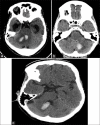Traumatic Cerebellar Hematoma: A Tertiary Care Experience of 23 Conservatively Managed Cases
- PMID: 33708658
- PMCID: PMC7869263
- DOI: 10.4103/ajns.AJNS_309_20
Traumatic Cerebellar Hematoma: A Tertiary Care Experience of 23 Conservatively Managed Cases
Abstract
Context: Traumatic cerebellar hematomas are rare in comparison to nontraumatic cerebellar hematomas.
Aims: The aim of this study is to evaluate the prognostic factors and outcome determining factors with regard to conservatively managed isolated traumatic cerebellar hematoma.
Settings and design: Retrospective cohort study.
Materials and methods: A retrospective study of 23 patients of conservatively managed isolated posterior fossa hematoma, admitted between August 2018 and May 2020, was conducted in the Department of Neurosurgery, Institute of Medical Sciences, Banaras Hindu University, Varanasi. Each of the patients was evaluated in terms of age, sex, mode of injury, clinical presentation, comorbidity, the severity of injury, best motor response, Glasgow Coma Scale (GCS) at admission, computed tomography findings, and Glasgow Outcome Scale at discharge/death.
Statistical analysis: Chi-square test and unpaired t-test were used. P < 0.05 was deemed statistically significant.
Results: Mean volume of posterior fossa contusion was 8.9 ml. The cerebellar hemispheric (60.9%) location of hematoma was more common. Age at presentation (P = 0.0086), best motor response (P < 0.0001), severity of injury (P = 0.0002), GCS at admission (P < 0.0001), effacement of basal cistern (P < 0.0001), fourth ventricular compression and intraventricular hemorrhage (P = 0.0008), presence of hydrocephalus (P = 0.0142), subarachnoid hemorrhage (P = 0.0008), and volume of posterior fossa contusion (P = 0.0002) were significantly associated with outcome of posterior fossa contusion.
Conclusion: Traumatic cerebellar hematoma is rare. Conservatively managed cerebellar hematoma patients must be monitored closely for neurological and radiological status. Patients who show deterioration in neurological or radiological status require surgical intervention.
Keywords: Conservative management; outcome; traumatic cerebellar contusion; traumatic cerebellar hematoma; traumatic posterior fossa contusion; traumatic posterior fossa hematoma.
Copyright: © 2020 Asian Journal of Neurosurgery.
Conflict of interest statement
There are no conflicts of interest.
Figures


Similar articles
-
Traumatic Posterior Fossa Hematoma, A Rare Entity: Study of 21 Cases.J Neurosci Rural Pract. 2019 Oct;10(4):675-682. doi: 10.1055/s-0039-1696610. Epub 2019 Nov 11. J Neurosci Rural Pract. 2019. PMID: 31853168 Free PMC article.
-
Institutional Experience of Post-Traumatic Posterior Fossa Extra Dural Hematoma: A Prospective Longitudinal Study.Turk Neurosurg. 2024;34(3):499-504. doi: 10.5137/1019-5149.JTN.44330-23.2. Turk Neurosurg. 2024. PMID: 38650570
-
Management of spontaneous cerebellar hematomas: a prospective treatment protocol.Neurosurgery. 2001 Dec;49(6):1378-86; discussion 1386-7. doi: 10.1097/00006123-200112000-00015. Neurosurgery. 2001. PMID: 11846937
-
Management of traumatic posterior fossa epidural hematomas in pediatrics: our experience and review of the literature.Childs Nerv Syst. 2021 Sep;37(9):2839-2846. doi: 10.1007/s00381-021-05248-y. Epub 2021 Jun 15. Childs Nerv Syst. 2021. PMID: 34129079 Review.
-
[Surgical Treatment for Traumatic Acute Subdural Hemorrhage in the Posterior Cranial Fossa:Three Cases Reports and Review of the Literature].No Shinkei Geka. 2017 Dec;45(12):1101-1107. doi: 10.11477/mf.1436203654. No Shinkei Geka. 2017. PMID: 29262392 Review. Japanese.
Cited by
-
Cerebellar tonsillar contusion in traumatic brain injury: an atypical presentation of previously undiagnosed Chiari I malformation.Childs Nerv Syst. 2025 Mar 19;41(1):135. doi: 10.1007/s00381-025-06795-4. Childs Nerv Syst. 2025. PMID: 40105965
-
Factors associated with post traumatic hydrocephalus following decompressive craniectomy: A single-center experience.Surg Neurol Int. 2023 Jan 20;14:18. doi: 10.25259/SNI_1121_2022. eCollection 2023. Surg Neurol Int. 2023. PMID: 36751442 Free PMC article.
-
Prognostic and morphological factors in pediatric cerebellar contusions.Surg Neurol Int. 2024 Apr 5;15:117. doi: 10.25259/SNI_988_2023. eCollection 2024. Surg Neurol Int. 2024. PMID: 38741990 Free PMC article.
-
Endoscopic Third Ventriculostomy for Obstructive Hydrocephalus Secondary to Delayed Intracerebellar Hematoma.Cureus. 2021 Aug 19;13(8):e17302. doi: 10.7759/cureus.17302. eCollection 2021 Aug. Cureus. 2021. PMID: 34552836 Free PMC article.
References
-
- d'Avella D, Servadei F, Scerrati M, Tomei G, Brambilla G, Angileri FF, et al. Traumatic intracerebellar hemorrhage: Clinicoradiological analysis of 81 patients. Neurosurgery. 2002;50:16–25. - PubMed
-
- Karasawa H, Furuya H, Naito H, Sugiyama K, Ueno J, Kin H. Acute hydrocephalus in posterior fossa injury. J Neurosurg. 1997;86:629–32. - PubMed
-
- Takeuchi S, Takasato Y, Masaoka H, Hayakawa T. Traumatic intra-cerebellar haematoma: Study of 17 cases. Br J Neurosurg. 2011;25:62–7. - PubMed
-
- D'Avella D, Cacciola F, Angileri FF, Cardali S, La Rosa G, Germanò A, et al. Traumatic intracerebellar hemorrhagic contusions and hematomas. J Neurosurg Sci. 2001;45:29–37. - PubMed
-
- Sato K, Hinokuma K, Matsuzawa Y, Takehara S, Uemura K, Ninchoji T, et al. Clinical study of traumatic cerebellar contusion. No Shinkei Geka. 1987;15:1285–9. - PubMed

